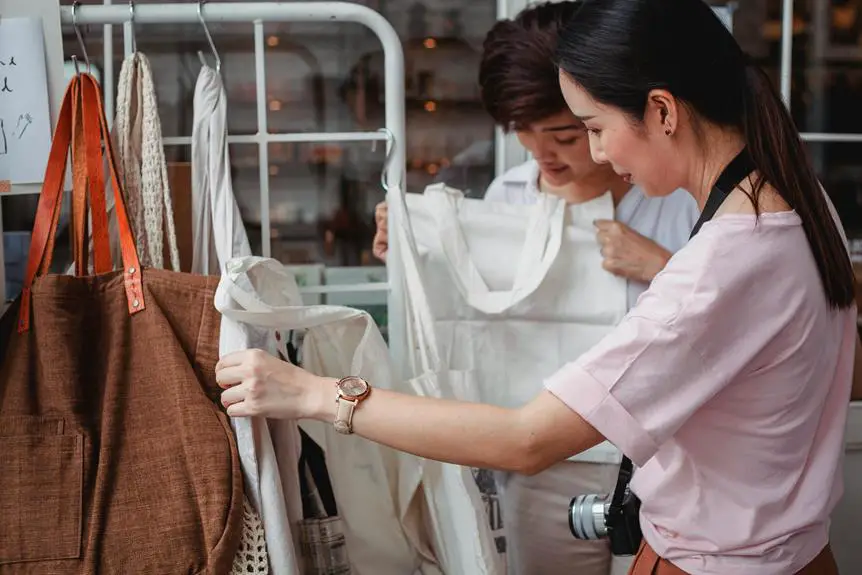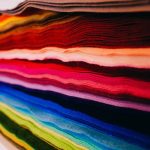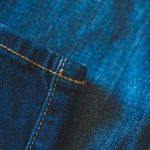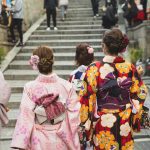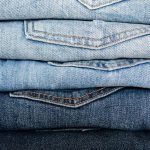When you think about eco-friendly fashion, broadcloth might not be the first fabric that comes to mind, but it deserves your attention. Its sustainable materials and innovative production methods significantly reduce environmental impact, making it a versatile choice for various styles. As you explore how broadcloth aligns with the growing demand for responsible fashion, you'll find that its benefits extend beyond just aesthetics. What happens when you consider the future of this fabric in a world increasingly focused on sustainability?
Table of Contents
What Is Broadcloth?
Broadcloth is a tightly woven fabric known for its smooth texture and durability, making it a popular choice in fashion. You'll often find it in dress shirts, blouses, and suits because it offers a polished look without sacrificing comfort. The fabric typically comes from cotton or a cotton blend, which enhances its breathability and softness against the skin.
When you choose broadcloth, you're also opting for a fabric that holds its shape well, resisting wrinkling and fading over time. This quality means you can wear your broadcloth garments multiple times without worrying about them losing their appeal.
Broadcloth's versatility allows it to be used in both casual and formal attire, making it a staple in many wardrobes. You can dress it up for a night out or keep it simple for everyday wear.
Additionally, the fabric's tight weave prevents it from being overly sheer, providing you with the confidence to wear it in various settings. Overall, broadcloth is a reliable choice that combines style with practicality, ensuring you always look your best.
Environmental Benefits of Broadcloth
When you choose broadcloth, you're opting for a fabric that prioritizes sustainability.
Its production methods are designed to minimize environmental impact, and its biodegradable properties ensure it won't linger in landfills.
Plus, the energy-efficient manufacturing process means you can feel good about your fashion choices.
Sustainable Fabric Production
Sustainable fabric production methods for broadcloth significantly reduce environmental impact, making it a smart choice for eco-conscious consumers. You'll find that many manufacturers now prioritize organic cotton, recycled fibers, or sustainably sourced materials, which help lower the carbon footprint associated with fabric production. By choosing broadcloth made from these materials, you're supporting practices that minimize pesticide use and promote water conservation.
Additionally, the dyeing processes used for broadcloth can also be eco-friendly. Many brands opt for low-impact dyes or natural dyes, which reduce harmful chemical runoff into waterways. This not only benefits the environment but also improves the overall quality of the fabric you're wearing.
As you explore your options, look for certifications like GOTS (Global Organic Textile Standard) or OEKO-TEX, which ensure that the production methods adhere to strict environmental and social standards.
Biodegradable Material Properties
Made from natural fibers, broadcloth offers biodegradable properties that significantly benefit the environment by breaking down more easily than synthetic materials.
When you choose broadcloth garments, you're making a conscious decision to reduce waste and promote sustainability. Unlike polyester or nylon, which can take hundreds of years to decompose, broadcloth will naturally return to the earth, enriching the soil rather than polluting it.
By opting for biodegradable fabrics like broadcloth, you help decrease the amount of landfill waste. When these materials decompose, they release nutrients back into the soil, supporting plant growth and promoting biodiversity.
Additionally, as broadcloth breaks down, it doesn't release harmful chemicals into the environment, making it a safer choice for both you and the planet.
Moreover, using biodegradable fabrics aligns with a circular economy, where resources are reused and recycled, reducing the need for new materials. This not only lessens the strain on natural resources but also minimizes greenhouse gas emissions associated with production and disposal.
Energy-Efficient Manufacturing Process
Broadcloth is often produced through energy-efficient manufacturing processes that significantly reduce carbon emissions and resource consumption. By utilizing advanced technologies and sustainable practices, manufacturers can create this versatile fabric while minimizing their ecological footprint. You'll appreciate how these methods not only benefit the environment but also enhance the quality of the final product.
Here's a quick overview of energy-efficient manufacturing benefits:
| Benefit | Description | Impact on Environment |
|---|---|---|
| Reduced Energy Consumption | Uses less energy compared to traditional methods | Lowers greenhouse gas emissions |
| Water Efficiency | Requires less water in the production process | Conserves vital water resources |
| Waste Minimization | Implements recycling and upcycling practices | Decreases landfill waste |
Broadcloth Production Processes
When you explore broadcloth production processes, you'll see how sustainable material sourcing plays a crucial role.
You'll also discover eco-friendly dye techniques that minimize environmental impact and energy-efficient manufacturing methods that conserve resources.
Together, these practices make broadcloth a standout choice in eco-friendly fashion.
Sustainable Material Sourcing
Sourcing sustainable materials for broadcloth production involves carefully selecting eco-friendly fibers and employing responsible manufacturing practices.
You'll want to look for organic cotton, which is grown without harmful pesticides and fertilizers, or consider Tencel, made from sustainably sourced wood pulp. These materials not only minimize environmental impact but also provide a soft, breathable fabric that's perfect for various applications.
When you choose suppliers, ensure they follow ethical labor practices and prioritize sustainability throughout their operations. It's essential to verify that your sources are certified by recognized organizations, which can help you maintain transparency in your supply chain.
You can also explore recycled fibers, such as those derived from post-consumer plastics, to further reduce waste and resource consumption. By incorporating these innovative materials, you contribute to a circular economy and promote a more sustainable fashion industry.
Additionally, consider local sourcing to reduce transportation emissions and support your community's economy. By focusing on sustainable material sourcing, you not only enhance the quality of your broadcloth but also align with eco-friendly values that resonate with conscious consumers.
This commitment can elevate your brand's reputation and help drive the future of fashion in a greener direction.
Eco-Friendly Dye Techniques
Innovative eco-friendly dye techniques are transforming how you can achieve vibrant colors in broadcloth without harming the environment. Traditional dyeing methods often use harmful chemicals that can pollute water sources, but new approaches are changing that narrative.
You can now explore natural dyes derived from plants, fruits, and minerals, which not only provide stunning hues but also reduce environmental impact. One popular method is using indigo dye, a natural pigment that creates rich blues and has been used for centuries.
Additionally, eco-friendly synthetic dyes, crafted from renewable resources, offer a sustainable alternative without sacrificing color quality. These dyes often require less water and energy in the application process, making them a smarter choice for eco-conscious consumers.
Moreover, techniques like digital printing allow for precise coloring with minimal waste, letting you customize designs while keeping your ecological footprint small. By opting for these eco-friendly dye techniques, you're not just adding color to your wardrobe; you're supporting a movement towards more sustainable fashion practices.
Embracing these innovations means you can look good while also feeling good about your choices.
Energy-Efficient Manufacturing Methods
Energy-efficient manufacturing methods are reshaping how broadcloth is produced, significantly reducing energy consumption and waste throughout the process. By adopting innovative technologies and practices, manufacturers are minimizing their carbon footprint while maintaining high-quality output. You'll find that techniques like air-jet weaving and digital printing not only save energy but also improve production efficiency.
Here's a comparison of traditional and energy-efficient methods in broadcloth production:
| Method | Energy Consumption |
|---|---|
| Traditional Weaving | High |
| Air-Jet Weaving | Low |
| Conventional Dyeing | High |
| Eco-Friendly Dyeing | Low |
As you can see, the transition to energy-efficient methods makes a significant impact. The reduced energy consumption leads to lower operating costs, which can be passed on to consumers. Plus, by choosing brands that prioritize these methods, you're supporting sustainable practices in the fashion industry. Remember, every small step counts towards a greener planet, and your choices in broadcloth fashion can contribute to this positive change.
Sustainable Fashion Trends
Sustainable fashion trends are reshaping the industry, encouraging you to embrace eco-friendly materials and practices that reduce your environmental footprint. You'll notice a shift towards biodegradable fabrics, recycled materials, and natural dyes that eliminate harmful chemicals. This movement isn't just about the materials; it's also about how you shop and what you buy.
You might want to consider the rise of capsule wardrobes, promoting minimalism and versatility in your clothing choices. By investing in timeless pieces, you reduce waste and encourage thoughtful consumption. Additionally, many brands are adopting transparent supply chains, allowing you to make informed decisions about where and how your clothes are made.
Another trend is the popularity of second-hand shopping. Thrift stores, consignment shops, and online resale platforms are making it easier for you to find unique items while promoting a circular economy. You'll also see more brands offering repair services to extend the life of your garments, emphasizing sustainability over fast fashion.
As these trends continue to grow, you're not just a consumer; you're part of a movement that values the planet and its resources. Embracing these trends can lead to a more sustainable, stylish wardrobe.
Styling With Broadcloth
When it comes to styling with broadcloth, you'll find its versatile nature makes it an excellent choice for both casual and formal outfits. The soft texture and smooth finish give broadcloth an elevated look, perfect for dress shirts or blouses. Pair a crisp white broadcloth shirt with tailored trousers for a professional appearance, or tuck it into a high-waisted skirt for a chic, polished vibe.
For casual outings, you can opt for broadcloth in vibrant colors or playful patterns. A loose-fitting broadcloth shirt layered over a tank top and paired with jeans creates a relaxed yet stylish outfit. Adding accessories like statement necklaces or colorful scarves can enhance your look and showcase your personality.
Because broadcloth is lightweight and breathable, it's also ideal for layering. You might wear a broadcloth button-up under a cozy sweater or a tailored jacket, allowing you to transition from day to night effortlessly.
Don't forget about the versatility of broadcloth dresses—pair them with sandals for a day out or heels for a night on the town. With broadcloth, your styling options are practically endless, making it a staple in any eco-friendly wardrobe.
The Future of Broadcloth in Fashion
Broadcloth is poised to play a pivotal role in the evolution of eco-friendly fashion, as designers increasingly prioritize materials that combine style with environmental responsibility.
You'll likely see broadcloth made from sustainable fibers, like organic cotton or recycled materials, gaining popularity in upcoming collections. This shift not only reduces environmental impact but also appeals to consumers who are more eco-conscious than ever.
As you explore future trends, keep an eye out for innovative dyeing techniques that minimize water usage and harmful chemicals. Brands are now investing in eco-friendly production processes, ensuring that broadcloth garments align with your values.
Moreover, the versatility of broadcloth means it can transition seamlessly from casual wear to formal attire, making it a staple in any sustainable wardrobe. You'll appreciate the durability and timelessness of broadcloth, which encourages you to invest in pieces that last rather than fast fashion.
In the coming years, expect collaborations between designers and sustainable fabric producers to further enhance broadcloth's appeal. As you embrace eco-friendly fashion, broadcloth will undoubtedly become your go-to choice for stylish, responsible clothing.
Frequently Asked Questions
Is Broadcloth Biodegradable or Recyclable?
Broadcloth isn't biodegradable, as it's usually made from cotton or synthetic fibers. However, you can recycle cotton broadcloth if it's clean and free of contaminants, so check your local recycling guidelines for options.
How Does Broadcloth Compare to Other Eco-Friendly Fabrics?
When you compare broadcloth to other eco-friendly fabrics, you'll find it's durable and versatile. However, it may not be as biodegradable as organic cotton or hemp, which are often considered more sustainable options for eco-conscious consumers.
Can Broadcloth Be Used for Activewear?
Yes, you can use broadcloth for activewear. Its lightweight and breathable nature makes it suitable for movement, while its smooth texture adds comfort. Just ensure the fabric blends well with materials designed for high-performance activities.
What Are Common Blends Used With Broadcloth?
Common blends with broadcloth include cotton-polyester for durability, cotton-spandex for stretch, and linen-cotton for breathability. These combinations enhance the fabric's qualities, making it versatile for various clothing styles and practical for different uses.
Is Broadcloth Suitable for All Seasons?
Yes, broadcloth's versatility makes it suitable for all seasons. Its lightweight nature allows for breathability in warmer months, while it can be layered for warmth in colder weather. You'll find it comfortable year-round.
- How Does Ring Spun Cotton Affect Garment Fit and Shape Retention? - August 13, 2024
- What Are the Challenges in Producing Ring Spun Cotton? - August 13, 2024
- Is Ring Spun Cotton Suitable for Plus-Size Clothing? - August 13, 2024

